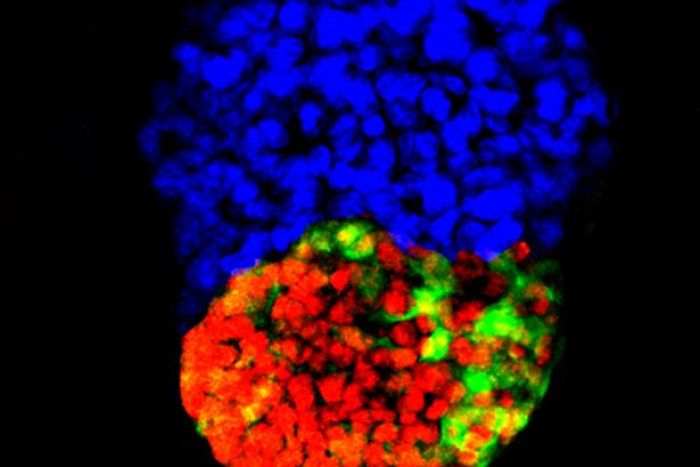First artificial mouse 'embryo' may help answer why human pregnancies end early
Posted
 Photo:
The artificial mouse "embryo" is shown at 72 hours. (Supplied: Cambridge University/Berna Sozen-Kaya/Zernicka-Goetz Lab)
Photo:
The artificial mouse "embryo" is shown at 72 hours. (Supplied: Cambridge University/Berna Sozen-Kaya/Zernicka-Goetz Lab)
For the first time, scientists have created a structure resembling a mouse embryo, using a 3D scaffold and two types of stem cells, in research they say will deepen the understanding of the very early stages of mammalian development and could help explain why two-thirds of human pregnancies fail at that time.
The team, based at England's Cambridge University, were able to show how the artificial embryo followed the same pattern of development as a normal embryo, with the stem cells organising themselves in the same way.
 Photo:
The artificial mouse "embryo" at 96 hours. (Supplied: Cambridge University/Berna Sozen-Kaya/Zernicka-Goetz Lab)
Photo:
The artificial mouse "embryo" at 96 hours. (Supplied: Cambridge University/Berna Sozen-Kaya/Zernicka-Goetz Lab)
The success with mouse cells should pave the way for similar work with human cells, helping scientists overcome a major barrier to human embryo research — a shortage of embryos, Cambridge department of Physiology, Development and Neuroscience Professor Magdalena Zernicka-Goetz, who led the work, said.
Currently, human embryos for research are developed from surplus eggs donated through fertility clinics, but Professor Zernicka-Goetz said it should in future be possible to use the stem cells and scaffold technique to make artificial human embryos for study.
"This will allow us to study key events of this critical stage of human development without actually having to work on embryos," she said.
"[And] knowing how development normally occurs will allow us to understand why it so often goes wrong."
Previous attempts to grow embryo-like structures have not had much success.
The Cambridge team said they now think this was because these experiments used only one type of stem cells — embryonic stem cells (ESCs) — and did not allow for the fact early embryo development requires different types of cell to coordinate closely with each other.
 Photo:
The artificial mouse "embryo" 100 hours after it was created. (Supplied: Cambridge University/Berna Sozen-Kaya/Zernicka-Goetz Lab)
Photo:
The artificial mouse "embryo" 100 hours after it was created. (Supplied: Cambridge University/Berna Sozen-Kaya/Zernicka-Goetz Lab)
For this work, Professor Zernicka-Goetz's team used ESCs along with another type called extra-embryonic trophoblast stem cells (TSCs).
"Both the embryonic and extra-embryonic cells start to talk to each other and become organised into a structure that looks like and behaves like an embryo," Professor Zernicka-Goetz said.
But the scientists noted that while the artificial embryo closely resembled the real thing, it would be unlikely to develop further into a healthy mouse foetus.
Stem cell specialists not directly involved in the work, published in journal Science, praised its methods and said the results would prove valuable in deepening scientific understanding of embryonic development.
Dusko Ilic, a reader in stem cell science at King's College London, described it as a "masterpiece" and "a beautifully conceived and executed study demonstrating interplay of different cells in different cellular compartments within the first days of mouse development".
ABC/Reuters
Topics: science-and-technology, reproduction-and-contraception, biology, stem-cells, pregnancy-and-childbirth, medical-research, research, united-kingdom







